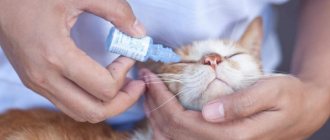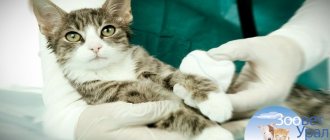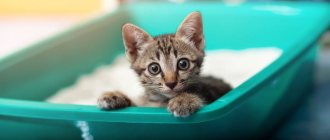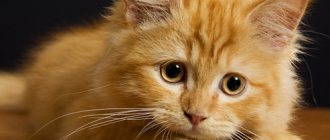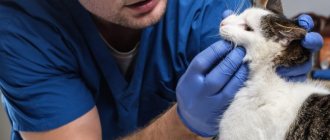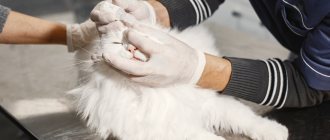For various reasons, the furry pet or the cat's eyes are running. We will discuss in more detail what to do and what to do in this article, which will tell you when such a condition is normal, and when you should run to the veterinarian. This could be anything from a simple allergy to scratches that require immediate veterinary attention. A cat's eyes are a complex platform that does not tolerate experimentation.
Symptoms to watch out for
Disease or common occurrence? When you notice that your cat’s eyes are running, then before taking any measures, it is worth observing and analyzing the behavior and habits of the animal in order to understand whether this is a dangerous disease, or whether your pet has a common phenomenon for their family.
© shutterstock
What should you pay attention to? Let's answer some questions :
- Does your cat still have a fun and carefree time, or has he become unsociable and is hiding even from you?
- Has your baby's appetite changed?
- How does a pet react to sunlight?
- Are there any visible injuries or scratches around the eyes?
- What color is the discharge from the eyes of cats? Are they transparent with a gray or red tint? Or is it purulent secretions?
- Has the eye color changed?
- Has your pet's temperature increased?
Perhaps when you answer these questions, you will then clearly understand that there is little reason for concern. And the appetite is normal, and the behavior has not changed, and the cat’s eyes are streaming with a substance similar to tears.
Then a completely logical question arises: why do the cat’s eyes run? And the next question: what to do to rid your pet of this?
But before we try to answer these questions, we must admit that not everyone’s forecasts are so optimistic. There are those who have noticed that their pet’s behavior, appetite and habits have changed, a wound is noticeable in the eye or the discharge is clearly purulent in nature. We are also ready to help all owners of sick animals. So, why do pets' eyes water?
The cat's eyes are running: how to treat it
Diagnosis is made based on clinical examination and history. The owner reports on the animal’s age, latest vaccinations, treatments against worms and fleas, and diet. In doubtful situations, the veterinarian prescribes additional tests of swabs from the conjunctiva, as well as blood.
Without waiting for test results, the veterinarian prescribes symptomatic treatment. If there is a suspicion of a viral or bacterial disease, immunomodulators, antibiotics, anti-inflammatory and painkillers are prescribed. Antihistamines are used to eliminate allergy symptoms. For mild lacrimation, use the same means as for hygienic treatment.
If crusts, mucous exudate or pus appear, first prepare the conjunctiva for the action of drops or ointments. They talk to the pet affectionately, praise him for his calm behavior and treat him with a treat. The veterinarian instructs the cat owner, who will have to perform treatment procedures several times a day for 5-7 days or the period prescribed by the veterinarian.
For your own safety, you should wear disposable gloves and wash your hands thoroughly. Microbes. causing eye diseases feel equally good on the feline conjunctiva and on the human conjunctiva. After deciphering the results of laboratory tests, treatment is adjusted.
Reasons why a cat's eyes are watery
Let's consider the first option, when lacrimation is not a disease
Why might there be a problem with the organs of vision if the animal is healthy?
There are several good reasons for this:
- Unsuitable diet for your cat.
- There are breeds, for example, Scottish, in which the structure of the muzzle, in particular the tear duct, is such that it seems that the cat’s eye is constantly leaking.
- The cat slept for a long time, and as a result a similar problem may arise.
- The cat does not have allergies, but some aggressive chemical components, hygiene products, detergents and detergents, medications, etc., can cause an allergic reaction, a sign of which will be discharge from the eyes.
All these cases are common occurrences. But this only indicates temporary discomfort for the murka. The reason will go away, the cat’s eyes will not run. These are tears. And you should not sound the alarm if it turns out that they have some unusual color, for example, slightly cloudy, reddish or grayish.
© shutterstock
At least you need to watch the cat for a while. If the reason that caused the problem goes away, or we neutralize it, and the kitten continues to “cry,” then, most likely, the pathogen is something else and the problem is much deeper.
Moreover, tears themselves do not look attractive. And even if the problem itself is only aesthetic, it needs to be solved. There are suitable and inexpensive methods and affordable means for this that can be found in every home.
Let's consider the second option, when if there are reasons why the cat's eyes may be watery, and she is actually sick. Which?
Here are the most common and widespread:
- Even a domestic cat can get parasites. And the eyes that flow show it.
- Any type and complexity of injury. The cat got into a fight and the enemy cut his eye, or our tomboy fell off the cabinet and hurt his head. These and other injuries can form the basis of a very complex process, which will lead to the fact that the eye begins to fester.
- Infectious inflammation of the conjunctiva is something that many of our pets encounter due to their free lifestyle or our inept handling of them.
- Bacteria and fungi. It is difficult to completely neutralize this reason. But it is possible to quickly cure the eyes of cats if you start the right treatment.
- Allergy. Did you know that our four-legged friends are very sensitive and all the products we use to clean our home are very harmful to them? But that’s not all; often, in pursuit of savings, we can harm our pet if we choose low-quality cat care products.
- Intolerance to certain medications also leads to the kitty developing a reaction where the eyes run.
- Blepharitis is inflammation of the eye. This disease can occur due to any type of injury: eyelid bruise, chemical burn, cut or tear. But it doesn't stop there. Further, the wound becomes infected due to the fact that viruses and microbes can freely enter the eye. The eye swells and begins to fester.
The reasons are all serious enough for you to start treating your cat without delay. After all, the point is not only in the appearance of the fluffy, but also in the fact that he feels great discomfort, his eye itches and itches. And when he starts scratching it, he makes the problem even worse. The wound does not shrink, but increases, which means the area of access to microbes and viral infections increases. And his paws are not that clean, which is how he spreads the infection.
Our decision to cure the cat has matured, and we want to do it quickly and without special expenses. This is why many decide to treat at home, armed with old antiquated remedies and Wikipedia, which should know everything . But there is a huge and significant minus in all this. Which? Think about it! Do you know exactly what caused your pet’s illness? We found out that there may be several reasons. But why exactly are your furry furry's eyes running?
© shutterstock
Even if it seems to you that you know exactly the answer to this question, then do not rush, for fear of harming your pet. It's best to be sure. To do this, you should consult a doctor.
Why do my cat's eyes run?: reasons
Discharges from the organs of vision occur for physiological and pathological reasons. An attentive cat owner is able to make a preliminary diagnosis himself and knows what to do: contact a veterinarian or solve the problem on his own.
Diseases that cause excessive lacrimation in cats
Eye diseases indicate a weakened immune system, which is characterized by additional symptoms and is caused by contagious or non-contagious diseases.
Among the contagious diseases are the following:
- Panleukopenia;
- Rhinotracheitis;
- Calicivirus infection;
- Chlamydia;
- Toxoplasmosis;
- Nematodes.
The most common non-communicable causes include:
- Allergy;
- Diabetes;
- Chronic diseases of the digestive system, liver, kidneys;
- Hair getting into the eyes;
- Mechanical injuries.
Suspicion of pathology arises when the following symptoms occur:
- ulceration of the cornea due to rhinotracheitis;
- ulcers on the tongue due to calicivirus;
- diarrhea, dehydration, heart failure with panleukopenia;
- first unilateral, then bilateral conjunctivitis with chlamydia;
- conjunctivitis, turning into uveitis (inflammation of the vascular region) with toxoplasmosis;
- allergic reaction: swelling of the eyelids due to nematodes;
- dermatitis, tear tracks on the cheeks (epiphora) with allergies.
Treatment and prevention of diseases of the organs of vision
Everyone knows the golden rule of medicine: the first step to recovery is an accurate diagnosis. This means that the best way to treat a cat whose eyes are watery is to visit a veterinarian. He will examine the eye, perhaps take tests and ask about the disease, how it started and how it progressed. And only after that he will decide what to appoint.
What can help if a cat's eyes are running?:
- Rinsing the eyes with warm chamomile decoction;
- Washing with furatsilin;
- Boric acid solution (for 50g of warm water you need 1 tsp of 0.02% acid).
These remedies are gentle. They sometimes need to be used as a preventive measure. The main condition is that the cotton wool or bandages do not damage the eyes. That is why the tampon is dipped in solutions and decoctions. And they don’t rub it over the eye, but squeeze it out to drop it into the eye. And this needs to be done several times. It is advisable to use a new cotton swab for this.
If the problem is more complex, then washing alone will not be enough. You need to carefully pull back the lower eyelid and apply antibiotic cream there. What products: creams and drops are recommended to be used if cats have tears:
Natural causes
The eye can become watery not only as a result of pathology, but also for natural reasons. It is worth noting that some cat breeds have severe lacrimation, which is due to the peculiarities of the anatomical structure of the lacrimal apparatus. These breeds include Persian and British cats. In this case, there is no need to treat anything; it is enough to carry out hygiene procedures regularly.
Increased lacrimation may also be associated with age. For example, in a small kitten this is a variant of a defensive reaction.
In general, if lacrimation is normal, it will be characterized by the following features:
- the mucous membrane of the eye is pink and shiny (not dull);
- the discharge is mucous in nature (without admixtures of blood or pus);
- the pet’s well-being is not affected (the cat is active, the temperature is not elevated);
- there are no foreign objects;
- Both eyes are watering, not just one.
If lacrimation is accompanied by other symptoms, you need to look for a pathological cause.
Recovery
Your cat's prognosis will depend on the cause of the disease. In most cats, eye inflammation resolves with proper treatment. As with most antibiotic treatments, you may see symptoms begin to subside before the recommended treatment time has elapsed. However, it is absolutely necessary to continue taking the medicine for the entire prescribed treatment period. Failure to do so may cause an aggressive relapse.
If you've ever tried to give your cat eye drops or ointments, you know it can be difficult. Eye drops prescribed for eye inflammation often require frequent dosing, up to 6 times a day. You may find it easier to deliver these medications if you have another person to help you keep your cat still. If you are unsure, ask your veterinarian to show you how to administer the medication.
How to rinse a cat's eyes or apply drops?
In order not to injure yourself and the cat, it is better to wash your eyes or instill drops together. First, you need to wrap the animal in thick cloth and gently press it between your knees. The second person, holding the animal's head, carefully performs the necessary procedures. After this, the cat must be held in a motionless position for 10-15 seconds, and only then can it be released. If the procedure is performed by one person, then it is best to position the cat with its back to you. This way she will not be afraid of a large number of foreign objects.
To wash each eye, you must use a separate cotton pad or swab to prevent infection transfer. If the doctor has prescribed drops, then the animal’s eyes must also be washed before using them.
During the process of washing or instilling, you need to talk to and pet your pet. This will calm the cat, and the treatment procedures will take place without unnecessary nerves, both for the animal itself and for its owner.
What to do and how to treat?
Before visiting the doctor, you can wipe your pet’s eyes with a herbal decoction.
If the owners notice that the cat’s eyes are festering and other alarming symptoms are recorded, then they should not delay a visit to the veterinarian. At home, it is possible to treat the visual organs with decoctions based on chamomile, calendula and other medicinal herbs that have antimicrobial and antiseptic effects. After conducting a comprehensive examination and identifying the root cause of the problem, the pet is prescribed medications.
You should not apply any eye drops to cats for pus at your own discretion, since there is a high probability of worsening the disease and developing complications. In most cases, it is possible to cope with unpleasant symptoms in a pet with the help of the following ophthalmic medications:
- "Iris";
- "Leopard";
- "Diamond Eyes";
- "Levomycetin".
For a speedy recovery of your pet and elimination of pathological exudate, you need to know how to properly apply eye drops to a cat. To do this, the pet's head is fixed so that the visual organs are directed upward. It is better to perform the manipulation together to ensure reliable fixation of the cat. The pipette must be kept at a distance of 2 centimeters from the eye, so that in case of sudden movement it does not damage the mucous membrane of the eye. Treatment is carried out until the animal recovers completely, until the discharge completely stops appearing.



